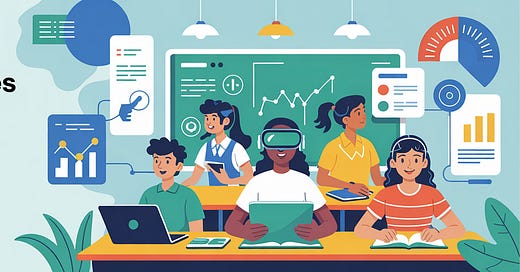Artificial intelligence (AI) has moved firmly from theory to practice in education. In 2025, its integration is becoming more sophisticated:
AI-Powered Tutoring Systems: Imagine an AI tutor not just presenting information, but actively adapting math problems based on a student's real-time struggles or offering immediate, targeted feedback on essay drafts. These sophisticated systems are becoming more common, providing personalized learning paths at scale. Learn more about the potential of AI in personalized learning from resources like this report on AI and personalized learning from the U.S. Department of Education.
Streamlined Teacher Workflows: AI tools are increasingly valuable allies for educators, assisting with time-consuming tasks like grading assignments (especially multiple-choice or short answer), suggesting resources for lesson planning, and automatically flagging potential learning gaps across a classroom. This frees up crucial teacher time for direct student interaction and support. Explore examples of AI tools for educators on platforms like this directory of AI education tools from EdSurge.
Ethical AI Discussions: As AI becomes more embedded, crucial conversations about data privacy, mitigating algorithmic bias, and ensuring equitable and responsible implementation are intensifying. Engage in the ethical considerations of AI in education through discussions and resources from organizations like the UNESCO's work on AI and ethics.
2. Renewed Focus on Foundational Skills & Well-being
Amidst technological advancements, there's a powerful counter-current emphasizing core human skills and wellness:
Back to Basics: Recognizing the critical importance of fundamental skills, many districts are intensifying efforts in foundational literacy and numeracy. This is sometimes driven by recent assessment data revealing learning gaps (similar to insights gained from analyzing state tests like STAAR or local interim results). Understand the importance of foundational literacy through resources like this report from the National Reading Panel.
Social-Emotional Learning (SEL): SEL isn't just an add-on; it's increasingly woven into the fabric of the school day. More schools are implementing evidence-based strategies to support student mental health, build resilience, and teach essential interpersonal skills. Discover evidence-based SEL programs and resources from CASEL (Collaborative for Academic, Social, and Emotional Learning).
Teacher Well-being: The crucial link between supported, healthy teachers and positive student outcomes is gaining wider recognition. This translates to more initiatives focused on preventing burnout, providing mental health resources for educators, and creating more sustainable working conditions. Learn about teacher well-being initiatives and research from organizations like the National Education Association (NEA) Healthy Educators resources.
3. Evolving Curriculum and Assessment Methods
What students learn and how we measure that learning are undergoing significant shifts:
Skills-Based Learning: Beyond subject mastery, there's a growing focus on equipping students with durable, transferable skills vital for the future: critical thinking, creative problem-solving, effective collaboration, and digital literacy are becoming curriculum cornerstones. Explore frameworks for 21st-century skills from organizations like the Partnership for 21st Century Skills (P21) (now part of Battelle for Kids).
Authentic Assessment: The limitations of relying solely on standardized tests are leading educators to embrace more authentic methods. Project-based learning, student portfolios showcasing growth over time, and performance-based tasks that mirror real-world challenges are gaining traction. Find resources and examples of authentic assessment strategies from ASCD (Association for Supervision and Curriculum Development) on authentic assessment (Note: While this specific link is an older article, ASCD remains a valuable resource for current information – search their site for "authentic assessment").
Micro-Credentials and Alternative Pathways: Learning is increasingly viewed as a lifelong journey extending beyond traditional degrees. Interest is surging in micro-credentials, badges, and skills-based certifications offered by universities, colleges, and specialized providers, offering flexible pathways for career advancement. Consider learning more about micro-credentials in education from World Education Services (WES) article on micro-credentials.
4. Policy and Funding Shifts Continue
Government action and resource allocation remain powerful levers shaping the educational environment:
Digital Equity Focus: While progress has been made, persistent efforts continue to bridge the digital divide, ensuring all students have reliable access to devices and high-speed internet needed for modern learning. Consider reviewing the FCC's reports and data on the digital divide for a deeper understanding of the issue.
Teacher Recruitment and Retention: Addressing nationwide teacher shortages remains a top policy priority. States and districts are experimenting with diverse strategies, including signing bonuses, enhanced mentoring programs, innovative training pathways, and improved compensation structures. For insights on teacher recruitment and retention policies, explore reports from the Learning Policy Institute (LPI) on teacher workforce.
Debates on Curriculum Standards: Ongoing discussions about curriculum content, the role of state standards (like the TEKS in Texas), parental involvement, and academic freedom continue to shape educational policy at local and state levels. Stay informed on curriculum debates and policy through resources from organizations like Education Week which provides ongoing news and analysis of education policy.
Looking Ahead: What's Next for Education in 2025?
The education changes 2025, so far, reveal a sector grappling with innovation while reinforcing foundational values. Technology presents unprecedented opportunities for personalization and efficiency, yet there's a clear commitment to nurturing essential skills and prioritizing the well-being of both students and educators. These learning trends in 2025 are likely to deepen as the year unfolds, influenced by ongoing research, policy evolution, and the invaluable experiences from classrooms worldwide.
Staying informed is crucial, but what are you seeing on the ground? What educational shifts are most impacting your community? Sharing insights helps us all navigate the future of learning.
(Disclaimer: This blog post discusses general trends observed up to March 2025. Specific changes may vary significantly by region and institution.)





